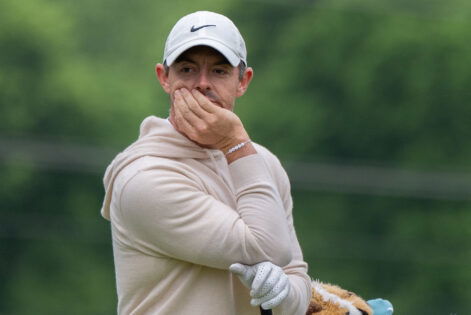That perfect driver in your bag—the one that just feels right in your hands. You’ve hit countless balls with it. The face has tiny battle scars. The sweet spot seems to get sweeter with time. For weekend golfers, this evolution is bliss. For pros like Rory McIlroy, it can suddenly become a rules violation.
McIlroy faced precisely this dilemma right before the PGA Championship began. His trusted TaylorMade Qi10 driver—the club he’d carefully calibrated to his swing—failed USGA testing. “Rory McIlroy’s ‘gamer’ driver was deemed non-conforming by USGA,” reported Underdog Golf via Twitter, citing Jason Sobel’s findings. The issue likely stems from “driver creep”—when club faces become more flexible with repeated use. This naturally occurring phenomenon has caught several top players off guard.
Rory McIlroy’s “gamer” driver was deemed non-conforming by USGA, via @JasonSobelGolf.
Switched drivers before R1 of PGA Championship.
— Underdog Golf (@UnderdogGolf) May 16, 2025
In 2019, Xander Schauffele experienced similar problems at The Open. His driver also failed testing, creating controversy when his name leaked while others remained private.
McIlroy struggled after the last-minute switch. He found only four fairways during his opening round, contributing to a disappointing 3-over 74.
This incident raises compelling questions about equipment evolution, testing protocols, and the fine line between technological advantages and rule violations in professional golf. What exactly makes a driver non-conforming? The answer lies in the “CT” test. This measures the springiness of the club face. Over time, repeated impact makes the face more flexible. The face essentially becomes “hotter” through natural use.
McIlroy has faced this issue before. In a March 9, 2023, interview with Golf.com, he noted about a previous driver, “You use a driver for so long, and it starts to get a little too… basically, it just wouldn’t pass the test.” McIlroy has not publicly commented on this current situation.
This creates a paradox for players. Their equipment improves naturally with use. Yet this improvement eventually pushes them over the regulatory line.
Schauffele’s situation in 2019 highlights another dimension. The R&A tested 30 drivers at Royal Portrush. Several failed. Yet only Schauffele was publicly identified. “To make it fair they should test everybody,” Schauffele said in July 2019 during The Open. “The R&A pissed me off because they attempted to ruin my image by not keeping this matter private.”
The consequences can be severe. Using a non-conforming driver during play results in immediate disqualification. Fortunately, McIlroy discovered the issue before his first round.
The technological tug-of-war in golf equipment continues to challenge the sport
The McIlroy and Schauffele incidents point to a broader conversation in golf. How much advantage should technology provide? The game constantly balances innovation against tradition.
Manufacturers build clubs that approach the very limits of legality. The closer clubs reach these limits, the more likely they will cross over with natural wear. The USGA and R&A have recently increased scrutiny on equipment. They worry about the distance explosion in professional golf. Longer drives change how historic courses play.
Random testing has become standard at major championships. Officials select players’ clubs for examination behind the scenes. Many pros now travel with backup drivers specifically for this reason. For average golfers, this issue rarely matters. Recreational players’ clubs aren’t tested.
The technological arms race continues between manufacturers, players, and governing bodies. Each new design pushes closer to the boundaries, and officials respond with more stringent testing.
The post Leak Reveals Rory McIlroy Was Caught With Illegal Equipment Before PGA Championship Began appeared first on EssentiallySports.
